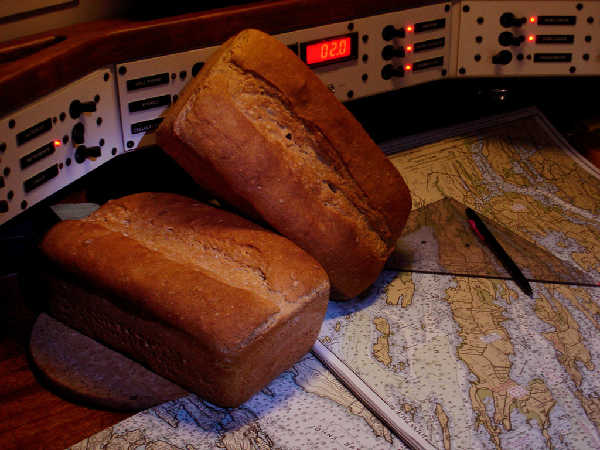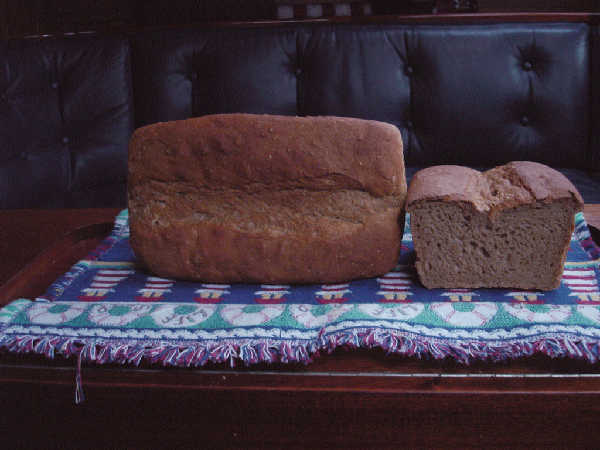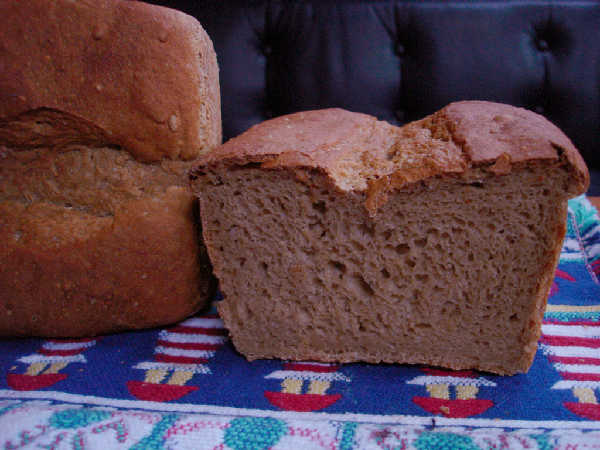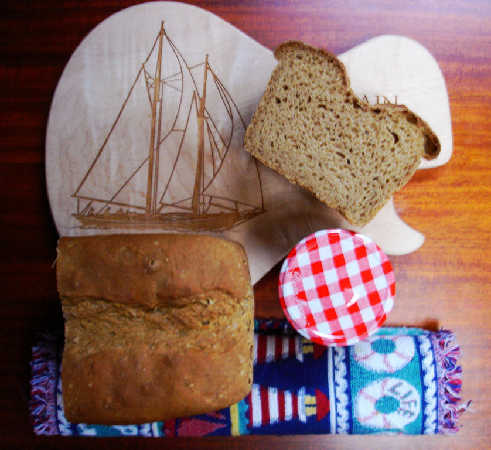
Seawater Sourdough Wheat Bread

Xma commented about trying seawater in bread on a diving trip. I decided to give this a try.
Please note: I have not researched health hazards that may result from using raw seawater directly in bread dough.
Based on some discussion on the internet, it seems that seawater has a salinity of approximately 32 to 35 parts per thousand. However, not all of the ions are Na+ or Cl-. In fact, seawater is a complex combination of various salts. However, as a naive assumption, I used 3.2% grams of salt per grams of water to approximate the saltiness of the seawater. One of the web sites indicated that the salinity in the Gulf of Maine, where I baked this bread aboard my sailboat, was 32 parts per thousand.

One of our crew members was able to obtain some KA White Whole Wheat Flour at a store in Portland on the way down to the docks, so we decided to make a whole wheat pan loaf. Just in case, a jar of percolating Glezer firm starter, fed the night before, was hidden in my duffel bag waiting for the grand seawater bread baking experiment.

We arrived at the docks and boarded "Chaos" a 40 foot sloop, and set off from Portland after having quickly fed the culture 1:2:2, expecting it rise again and then ripen a bit in time for an evening of a firm "recipe starter" preparation. We collected our seawater by using a seawater foot pump to draw seawater into bowls in the galley sink when we were at the eastern end of Casco Bay, about 1/4 mile southeast of White Bull Island, not too far from Cape Small. The winds were light, so we ghosted along, hardly spilling a drop of seawater. We therefore had plenty of our valuable test sample to use in the dough when we arrived in The Basin, a beautiful completely enclosed harbor on the eastern side of Casco Bay.

Seawater Sourdough Whole Wheat Recipe
Ingredients
Please see a spreadsheet with quantities in grams and ounces and baker's percentages.
Recipe Starter:
- 114 grams (4 oz) of fully active, ripe 100% Hydration Starter (In my case I took my Glezer firm starter and fed it 1:2:2 with KA White Whole Flour and water such that I would have approximately equal weight flour and water, and allowed this to ferment for about 8 hours)
- 283 grams (10 oz) whole wheat flour (I used KA White Whole Wheat flour, which is what was available)
- 198 grams (7 oz) water
Dough:
- 652 grams (23 oz) seawater drawn from the coast of Maine at the east end of Casco Bay off of White Bull Island near Cape Small (if you draw the water from another location, you may need to consider the variation in salinity in different parts of the ocean in your calculations, or mix 32 grams per liter of fresh water and use as a seawater substitute).
- 99 grams (3.5 oz) fresh water. (I used water from the freshwater tanks, of dubious origin - the dock supply in Portland - laced with a touch of bleach to keep the tanks "sweet").
- 850 grams (30 oz) whole wheat flour (I used KA White Whole Wheat Flour)
Starter Preparation
I brought along a small amount of my new Glezer firm starter, thanks to consulting extensively with Zolablue, who has a thriving Glezer style firm starter and lots of great sourdough bread to prove it. I fed this starter with KA White Whole Wheat flour using the following: 32g Glezer starter:88g fresh water:80g KA WW. The mixture was stirred and allowed to rise while we sailed from Portland to The Basin in Casco Bay. Fortunately, it was a warm day, so the starter did rise just fine and was reasonably ripe later on in the afternoon when we made the recipe starter.
Recipe Starter
Around 6 P.M. the recipe starter was mixed. First add the recipe starter water to the 100% hydration starter and stir to fully mix the starter in the water, then mix in the flour. Knead into a dough, which should take about 3 minutes of kneading or less. Cover and allow to ferment until at least doubled. In this case, the temperatures were around 65F, and dropped down to about 55F over the course of the night, so we just allowed the starter to ferment all night. At room temperature, it would have taken about 5-7 hours to double this dough with my starter - your mileage will vary greatly of course.
Hydrate Flour
According to advice from whole grain experts, and realizing that seawater might impede the proper hydration and gluten formation in my KA White Whole Wheat Flour, I decided to give it a good long overnight soak in the seawater.
Mix seawater and freshwater together into a mass, cover, and allow to rest overnight in the refrigerator, or in our case, on the salon table where the temperature dropped down to about 50F overnight.
Mix Dough
In the morning, we mixed the dough. Take the mass of flour and water and lay it on a slightly wet counter and spread it into a large round disk like a pizza. Cut up the recipe starter into small pieces and push them into the larger flour mass, like toppings on a pizza. Roll up the dough and fold it a few times to begin mixing the starter with the dough. Since the hydration of this dough is fairly high, the starter and dough should mix together quickly and easily. I started the gluten formation and continued the mixing by spending about 30 seconds doing the following. Wet your hands and pick up one end of the dough, allow it to stretch with gravity, toss the other end on the table and pull it toward you, then flip the end you are holding over the dough in a folding action and pull your hands out and rewet them if necessary. Repeat this action a few times, rotating the dough each time.
Once the dough is well mixed and folded a few times, let it rest covered for an hour.
Fold Dough Periodically
To develop the gluten, fold it about once per hour for the first 3-4 hours. Some of my other blog entries (miche recipes) describe the folding technique, and there are even some photos of the steps. Hamelman describes the technique in "Bread", as well. This dough should rise in about 4.5 hours at room temperature with my starter. Again, your mileage will vary. However, it was cold on the boat. The dough started at a temperature of 55F. Luckily the sun managed to come out for a while and it warmed up, so the boat warmed up to about 70F for a few hours later on in the day. While we were sailing to Christmas Cove in Muscongus Bay, Maine, the dough rose nicely by a little more than double. The extra unexpected warmth probably resulted in a slightly overfermented dough, but not by much.
Shape Loaves and Final Proof
Two loaves were shaped approximately into batards, with the ends folded under, using JMonkey's video instructions. However, the dough was very wet and was a little too fermented, so it wasn't quite as easy as it looks in the video. Good luck - stay calm and don't overhandle the dough. Place the loaves in greased pans and cover. We placed the loaves in plastic bags and folded the opening to create a balloon for them to rise in.
Slash and Bake
Normally these loaves would proof in about 2.5 hours at room temperature. The boat was luckily at about room temperature, but we were also having too good a time cooking dinner and enjoying an after sailing happy hour. The boat warmed up inside, we had dinner, and before we knew it, the loaves had proofed for about 3 hours in the mid-70s. They seemed overproofed, but I tried slashing them anyway. At least they didn't collapse.
We baked in our anemic boat oven from a cold start for 1.5 hours at "400F", which means that it may have reached 400F at the very end of the bake, if that. Someone reflexively turned off the gas safety valve at that point, so although the loaves were just beginning to brown, we didn't realize the bake was over and the oven was off. These high hydration loaves do benefit from a good long bake, so our crumb turned out a little moist and the crust a little light. Still, the bread was good.
Results
The flavor was very good - not overly sour at all, but definitely a sourdough loaf. I am not a big fan of white whole wheat, but that's what happened to be available in the store. I don't know if the flour itself contributed a slight bitter flavor, or if this was a side effect of the seawater. While reading about how salt is made from salt water, I discovered that the process is more elaborate than just evaporating seawater and keeping what remains. Usually a series of evaporator ponds are used which allow some of the less desireable salts to precipitate out before and after the desired sodium chloride we know as ordinary salt is extracted. Some of the less desireable salts were said to have bitter flavors. So, it may be that I have effectively used "low quality" salt that has contributed a bitter flavor to the bread by using seawater. The bread was calculated to have 1.8% salt in baker's percentages, based on a salinity of 32 parts per thousand for Gulf of Maine seawater, yet it tasted less salty than that to me. There are seasonal variations I didn't try to take into account. Also, it seems salt in seawater is about 85% sodium chloride, if I read some of the discussions correctly, and maybe the salty flavor is only imparted by the sodium chloride and not by any other salts. If so, then I needed to increase the seawater or add a little more salt to make up for that.


Comments
I have to ask...where in Maine? I was born in Bar Harbor!
Hi TinGull,
I love the coast of Maine and go sailing there at least a few trips every spring. I work my way up from the Long Island Sound in early April, end up in Nantucket by early May, and get to Portland by late May. Then, I just keep on going. I always get to at least Northeast Harbor and usually to Bunker's Harbor on the other side of Schoodic Point. I often go up to Jonesport. On several occasions I've also sailed into the Bay of Fundy or across to Nova Scotia. I've been up to Whitehead Harbor in Nova Scotia and also into the St. John River and up to about Fredericksburg there.
I hope you are able to return from time to time. It's one of my favorite places, although Barry made it a little harder to bake bread. We raced into Camden ahead of the worst of it yesterday.
Bill
My girl is from Schoodic (Winter Harbor). We grew up just across the bay from eachother.
We're planning on moving back to Maine this summer (currently in Indiana).
Hi TinGull,
That is funny. I've anchored in Winter Harbor after making it around Schoodic quite a few times on the way back from Downeast Maine. There is a very good restaurant there, at least there was a few years ago. What part of Maine do you expect to move to?
Bill
Was that the restaurant? They aren't there anymore. Mama's Boy was a nice one too. The son of the lady who owns Burts Bee's owned that...but that's not there anymore either.
Im planning to move back to the Blue Hill area and building a straw bale home, off grid, all that. Im sick of living in the midwest where all I see are new subdivisions going up left and right and no one cares about what the earth has to offer them. Maine folks' really have it together in that respect.
Oh..the bread looks interesting! I would never have though to use Maine seawater. Maybe Caribbean water... ;)
I heard you have to have a million dollars to buy property in Blue Hill. Is that true? We went to see the Nearings place and loved that whole part of Maine but we were shocked at the cost of land. I hear the same has happened in much of Vermont. Am I wrong? weavershouse
Hi Weavershouse,
I don't really know. So far, I've been able to sneak around in the spring with almost no boats in the water and am able to go almost anywhere and moor or anchor. Later on around July 4th, it's gets tougher to find space for the boat if you want to leave the boat in Northeast Harbor for a week, let's say. It's still easy other than that, since I tend to wander around the offshore islands up toward Jonesport at that time, where you can still find anchorage and where even shortly after July 4th, it's still not that crowded. But the actual real estate I have not checked out. I would bet it's up there anywhere around Mt. Desert, though.
Bill
about Vermont--prices for a town or village house aren't impossible, but any what you would call buildable land is very expensive. I have a feeling it may be relative--Boston folks might find real estate here a steal comparatively, but certainly the locals don't.
You dont need a million dollars to buy land in Blue Hill. Half of that will get you a nice house on a few acres right in town. Outside of that, there's a couple towns minutes away from Blue Hill that have great pricing for plots of land. Where I used to live in Bar Harbor...now thats expensive property.
Mama's Boy sounds right. If that's the one, the owner was quite a talented chef and restaurant manager. It's a tough area to get enough business with the heavy seasonal nature of it. There's a good restaurant in Bunker's Harbor that was built a few years ago and seems to be doing OK. Good luck making it back. If you use Caribbean water, I think the salinity is a little higher, so you'll have to adjust the recipe... ;)
Oh, and I've made it into Blue Hill Harbor a few times, too.
Mama's Boy was priced out of business. Way too expensive for the locals to go and eat there. I think they lasted...maybe a season or 2. BUt I heard they were fantastic. I was living in Nashville at the time they were open. Bunkers Wharf was just up on the chopping block last summer for sale. Dont know if it was bought to continue as a restaurant or not, but it sure was a really pretty place. Can't wait to get back up there!
Ah...southern Maine. haha...sorry, didn't read the whole post first. I got excited when I saw someone was from Maine :)
Bill, another inventive idea from you! I love experimenting in the kitchen...or galley, in your case.
Katie in SC
Hi Katie,
I did manage to log on a couple of times with wireless hotspots in harbors we entered. I must say, your recent blog entries were spectacular. You're making great use of that starter.
Bill
Thanks, Bill! I have been having lots of fun lately with the bread. We now have a chest freezer full of meal accompaniments.
Katie
Bill - you found time! I am really impressed and my husband and I are getting a real kick out of your lovely photos with the charts in the backdrop! Now I must try the seawater bread in September...
I am wondering also if the slight bitter flavor could be from the white whole wheat flour, I was not crazy about the taste of it last time I tried it. Was there no hint of any seaweed or fishy flavor? I know right where Cape Small is also, my Aunt and Uncle live right near there. Too bad about Barry though, let's hope we don't get to many more of those storms this season, but it is early yet.
Great job and what a unique way to make bread! (Although who knows, maybe this was done a lot aboard ships in the old days to save fresh water, although they probably only had those hard-tack crackers to eat rather than bread).
Hi Mountaindog,
I thought you'd get a kick out of this, along with xma and maybe others. It's a little silly, but it was pleasing to make bread without using up freshwater in our tanks.
There was no hint of seaweed or fishy flavor at all. The water was drawn quite a ways off shore. It was absolutely clear sitting in the bowls. You would never guess it was anything but the purest water looking at it. In some ways, I'm sure it's better tasting than water from the freshwater tanks, which must necessarily be treated with a touch of bleach and doesn't taste as good as my well water by any stretch.
Bill
Fascinating experiment. Thanks for sharing the results with us.
Hi Floyd,
Thanks. It's a little off the beaten path in some ways. However, it's interesting to think about making bread on a boat. I know of a few sailors who think making bread aboard is a big enhancement to the experience. Salt is often almost an afterthought in bread baking, but often we use sea salt, which is just a refined version of using seawater, in a way.
Bill
Bill, very impressive indeed, as usual. You must have energy to burn. That's so awesome you took the time to figure this out and actually implement it. I love this experiment and would love even more to have been able to test your seawater bread. I'll bet there is nothing like smelling fresh bread baking out in the vast open waters. Welcome back and thanks for the great blog.
Hi ZB,
I hope you noticed that the Glezer starter is what I used for the bread. I put it into my duffel in a small jar. The idea was that the firm starter would be easier to transport and wouldn't ripen so much while I was traveling. Thanks for all the coaching on the Glezer starter conversion and maintenance details. It worked very well, even if it isn't quite as speedy as yours. Still hoping to get it there in the future with some more feedings.
Bill
Yes, Bill, I did notice you took the firm starter. I am so glad that was able to work for you. I just can't get over that you bake bread on a sailboat no matter how you do it let alone all this. Kudos! You are inspiring. :o)
Oooh...I haven't properly been to the ocean in years..your pictures and commentary are making me taste sea air. *sigh* Like many people I love the coast of Maine, you get as far east as Concord and the salt in your blood starts to rise. I went to Portland in November just long enough to run an errand, turn around and come home--didn't even stop for seafood. This all smacks of a Stevenson novel, Bill. It sounds like an absolute lark. And good to see you back 'on board'...
Browndog,
I'm glad you enjoyed the photos and the fun of it. At least some of it came through, but as I composed it all, I was imagining how good it would be to have your writing skills, or the photography skills for that matter. The photos of lilacs and unicorns had a heavenly quality. Your back yard is quite a spot.
We were cooking seafood aboard most of the time. I did manage to have a crab roll in Camden, and then another along with some local brew, after we snuck in ahead of the storm, feeling fatigued but far more secure.
Bill